


|
12 January 2009  Introduction: The year 2008 was a busy one in manned spaceflight. A total of seven manned flights were launched by three nations, with one already in orbit as the year began. Additionally, three different International Space Station Expeditions occurred within the year. All told, a total of eleven distinct missions played out over these twelve months. What follows is a summary of each of them. About Soyuz and ISS missions: For all intents and purposes each combined Soyuz flight and ISS Expedition, while serving as extensions as one another with the same crews over the same durations, are treated as separate missions. The ISS Expedition commander and flight engineer launch and land aboard the Soyuz with a spaceflight participant who is not a member of the Expedition crew and only spends a little over a week in space. Additionally, command-wise, the roles are often switched. If both are Russian, the Expedition commander serves as Soyuz flight engineer and the Expedition flight engineer serves as Soyuz commander. Otherwise the Russian crewmember serves as Soyuz commander and the non-Russian as Soyuz flight engineer, no matter their positions within the Expedition structure. About Asian naming conventions: The four Asian astronauts mentioned in this article – So-yeon Yi, Zhigang Zhai, Buoming Liu, and Haipen Jing – are rendered in the Western style. That is, given name first and family name last. This is to prevent confusion by displaying all names in the same style. 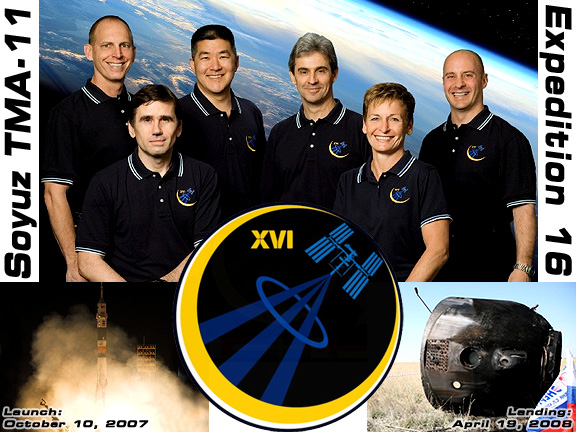
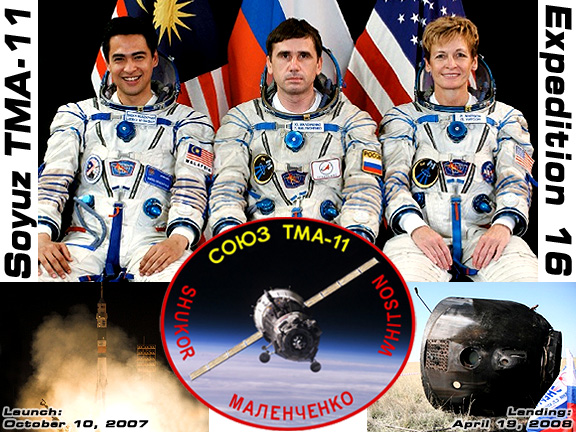 Expedition 16 | Soyuz TMA-11 Launched October 10, 2007 | Landed April 19, 2008 Soyuz TMA-11 crew: Yuri Malenchenko (Commander), Peggy Whitson (Flight Engineer), Sheikh Muszaphar Shukor (Spaceflight Participant – up), So-yeon Yi (Spaceflight Participant – down) Expedition 16 crew: Peggy Whitson (Commander), Yuri Malenchenko (Flight Engineer 1), Clayton Anderson (Flight Engineer 2), Daniel Tani (Flight Engineer 2), Leopold Eyharts (Flight Engineer 2), Garrett Reisman (Flight Engineer 2) The Mission: 2008 rolled in with Peggy Whitson, Yuri Malenchenko, and Daniel Tani serving out Expedition 16 on board the International Space Station (ISS). Whitson and Malenchenko had launched the previous October aboard Soyuz TMA-11 with Sheikh Muszaphar Shukor, the first Malaysian in space. Shukor returned to Earth after ten days with departing Expedition 15 crewmembers Fyodor Yurchikhin and Oleg Kotov on board Soyuz TMA-10. That same month STS-120 Discovery brought Tani to the station, relieving Clay Anderson as Expedition crewmember. Expedition 16, with Whitson as the first female space station commander, served out their residency, accomplishing five spacewalks and playing host for three visiting shuttle crews during their 191 days, 19 hours, and 20 minutes on board. STS-122 Atlantis, though much delayed, arrived bearing new crewmember Leopold Eyharts and the European-built Columbus module in February. This coincided with Whitson's birthday on the ninth, provoking jokes around Columbus being a special present especially for her. A month later, STS-123 Endeavour arrived to deliver Garrett Reisman and the first part of the sprawling Japanese-built portion of the station. Soyuz TMA-12's arrival with Expedition 17 in April brought Whitson and Malenchenko's tenure to an end, but their return was not without excitement of its own. With spaceflight participant So-yeon Yi (discussed later) aboard, a malfunction occurred in the explosive bolts that separates the descent module from the rest of the Soyuz vehicle. This triggered the computer to send the descent module into a steeper, ballistic reentry that incurred significantly greater forces on the crewmembers and threw the module 295 miles away from their intended landing. Although ballistic reentries aren't necessarily any more dangerous than a standard landing, the rough forces imposed on the crew means that this sort of landing is avoided whenever possible. Roskosmos chief Anatoly Perminov attributed superstition to the mishap, faulting the presence of more women than men on board the craft and that he would strive to ensure that ratio never happened again. This, of course, does not explain TMA-10's similarly ballistic reentry just six months prior, in a capsule that carried three men. Personal Anecdote: Expedition 16's ballistic reentry on April 19 was a bit nerve-wracking. I was watching NASA TV's coverage of the landing and began to grow increasingly concerned as the estimated time came and went. The minutes began to accumulate. If you've seen the end of Apollo 13, that might be a good analogy. Luckily, I had the Internet by my side and the reports of a steeper reentry trajectory and going wildly off course began to appear with the most important news regarding little risk for the crew. I had missed Expedition 15's similarly ballistic landing six months prior so I wasn't thinking about that situation at the time, only the worries that accumulate when a returning spacecraft is inexplicably overdue. 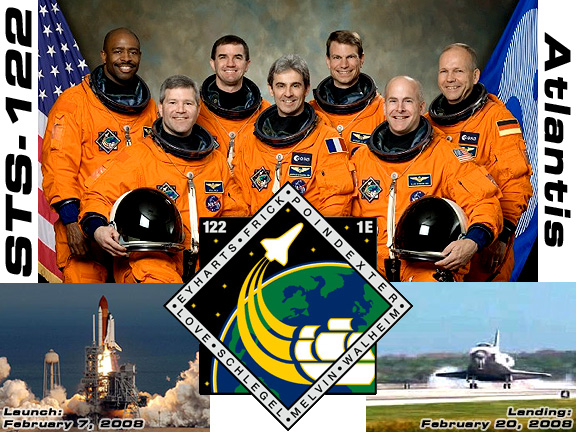 STS-122 | Space Shuttle Atlantis Space station construction flight 1E Launched February 7, 2008 | Landed February 20, 2008 Crew: Stephen Frick (Commander), Alan Poindexter (Pilot), Leland Melvin (Mission Specialist 1), Rex Walheim (Mission Specialist 2), Hans Schlegel (Mission Specialist 3), Stanley Love (Mission Specialist 4), Leopold Eyharts (ISS Flight Engineer 2 – up), Clayton Anderson (ISS Flight Engineer – down) The Mission: Space shuttle Atlantis had been scheduled to launch to the ISS on December 6, 2007 and launch day tanking of liquid hydrogen and liquid oxygen had begun when mission managers received failure messages from the Engine Cutoff Sensors (ECO). These are the sensors that tell the engines to cease firing if fuel runs begins to run low and their performance is mandatory for every flight. NASA had encountered ECO sensor problems on several earlier missions and each time these faults had been corrected without incident. The launch was rescheduled for December 8, then the ninth, and again the ECO sensors failed to correctly register the fuel in the tanks. Necessitating closer inspection, Atlantis' launch was pushed back until the new year. The vehicle had been rolled out to launch pad 39A on November 10, 2007 and mission managers weren't keen on moving the shuttle all the way back to the Vehicle Assembly Building to repair the sensors. Working on the ECO sensors on the pad, the launch slipped from January to February in order to ensure the workers had some time off during the holidays. The cause of the failure was eventually pinpointed: a series of wires in the ET feed-through connector that were slipping and had to be individually soldered to their connecting pins. This relatively simple problem had caused a two-month delay, but Atlantis launched without further incident at 2:45 PM on February 7 for the ISS. Delivering Peggy Whitson's birthday present, the Columbus module on behalf of the European Space Agency (ESA), Atlantis astronauts performed three spacewalks dedicated to its installation and other exterior station work. The mission's only notable post-launch hang-up came when Hans Schlegel, spacewalker on EVA 1, began feeling under the weather, thereby delaying the spacewalk twenty-four hours and sending Stanley Love out in his place. Schlegel took his place without problem on EVA 2, apparently feeling much better. NASA mission managers granted an extra two flight days to make up for lost time. Atlantis landed at the Kennedy Space Center at 9:07 AM on February 20, wrapping up a mission of 12 days, 18 hours, 21 minutes, and 40 seconds. Personal Anecdote: On February 7 I left the university early, skipping my afternoon art history class in order to get home in time to watch Atlantis' launch live. It was a bit of a gamble, given the delays the mission had incurred in the past two months, but boy it was worth it. Atlantis launched perfectly on schedule, an absolutely beautiful liftoff into a gorgeous blue Florida sky. Picture perfect. 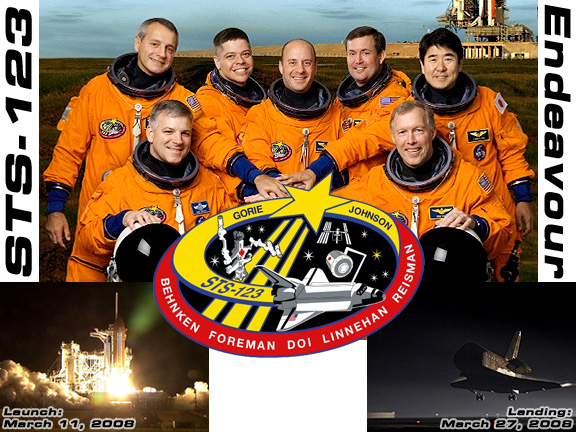 STS-123 | Space Shuttle Endeavour Space station construction flight 1J/A Launched March 11, 2008 | Landed March 27, 2008 Crew: Dominic Gorie (Commander), Gregory Johnson (Pilot), Robert Behnken (Mission Specialist 1), Michael Foreman (Mission Specialist 2), Richard Linnehan (Mission Specialist 3), Takao Doi (Mission Specialist 4), Garrett Reisman (ISS Flight Engineer 2 – up), Leopold Eyharts (ISS Flight Engineer – down) The Mission: Originally slated for a Valentine's Day launch, STS-123 was forced to slide back in to March after the delays caused by STS-122's ECO sensor glitches. Not wanting to risk a repeat of the same issues that so plagued the earlier flight, engineers performed in-situ soldering modifications to the ECO sensors on Endeavours' external tank before leaving the Vehicle Assembly Building for the launch pad. This precaution allowed the shuttle to launch at 2:28 AM on March 11 with its course set for a rendezvous with the ISS with new equipment and a new crewmember: Garrett Reisman would relieve Eyharts, the latter returning with the 123 crew. Mission STS-123 delivered the Experiment Logistics Module (ELM-PS), the first component of the Japanese-constructed Kibo complex. The ELM-PS, docked temporarily to the Harmony node, was just a small preview of what was to come with the delivery of more components on STS-124 and STS-127, eventually building Kibo into a very large section of the already immense station. This flight also took up the Special Purpose Dexterous Manipulator (SPDM), constructed by the Canadian Space Agency. Also known as Dextre, this large robotic manipulator "hand" can be grappled by the station's robotic arm and used to perform delicate operations that would otherwise have called for astronauts to venture outside the station on lengthy EVAs. These additions were accomplished over a series of five spacewalks, the last of which also included strapping the shuttle's Orbiter Boom Sensor System (OBSS) arm (used for heat shield inspections) to the exterior of the station in advance of STS-124, whose huge Kibo payload would have prevented the OBSS from being carried on the upward leg of the flight. After a record twelve days docked to the ISS, Endeavour landed at the Kennedy Space Center on March 27 at 10:39 PM. Exhaust burn-off from the Auxiliary Power Units (APU) near the vertical stabilizer caused news outlets to post sensational news immediately after touchdown of "space shuttle on fire," and the like. This was normal venting, only really seen in night landings, which just happened to be more visible than usual and was no cause for concern. In all, the total mission time clocked in at 15 days, 18 hours, 11 minutes, and 3 seconds – another record, making STS-123 the longest mission of the entire space shuttle program. Personal Anecdote: I was up ridiculously late on a school night for this launch and the subsequent press conference. In the days before STS-123 launched I assembled a massive, fully-illustrated chronology of the events leading up to liftoff that I was updating as the launch day photos were slowly coming in before the launch. For whatever reasons, I never got around to posting it. I should do that. 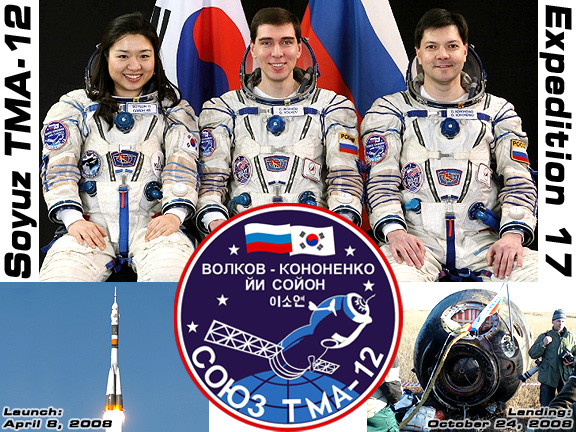
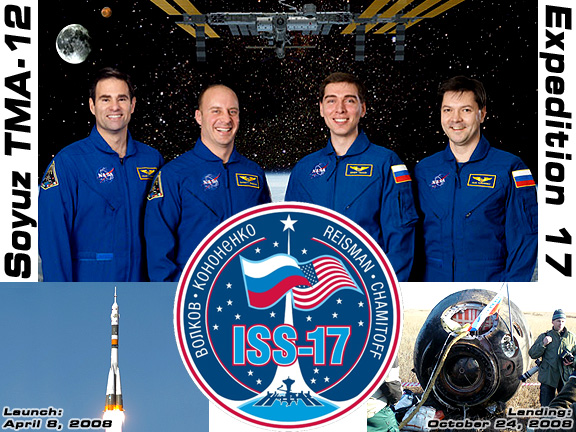 Soyuz TMA-12 | Expedition 17 Launched April 8, 2008 | Landed October 24, 2008 Soyuz TMA-12 crew: Oleg Kononenko (Commander), Sergei Volkov (Flight Engineer), So-yeon Yi (Spaceflight Participant – up), Richard Garriott (Spaceflight Participant – down) Expedition 17 crew: Sergei Volkov (Commander), Oleg Kononenko (Flight Engineer 1), Garrett Reisman (Flight Engineer 2), Gregory Chamitoff (Flight Engineer 2) The Mission: On April 8, Soyuz TMA-12 blasted off from the Baikonur Cosmodrome in Kazakhstan carrying Sergei Volkov and Oleg Konenko, who would make up Expedition 17, and spaceflight participant So-yeon Yi, the first Korean in space and only the second Asian woman. Flying under the auspices of the Korea Aerospace Research Institute (KARI), Yi performed a number of scientific research experiments during her ten days in orbit. She returned with Expedition 16 members Whitson and Malenchenko on TMA-11, injuring her back during the rough ballistic reentry. She has since recovered and continues to work with KARI. Expedition commander Volkov was the first second-generation space traveler, being the son of former Soviet cosmonaut Aleksandr Volkov. The elder Volkov had spent time on the Salyut 7 station and commanded two expeditions aboard the Mir space station. During his second Mir expedition in 1991 the Soviet Union fell apart, making himself and his crewmate, Sergei Krikalev, the "last citizens of the Soviet Union." During the younger Volkov's residency on the ISS, Russia exercised its Soviet roots and invaded Georgia, nearly triggering a major international crisis. Vokov and Kononenko, before seeing Expedition 16 off, inherited Reisman as the third member of Expedition 17. During the two-months between shuttle flights, the new station crew oversaw most of the unloading and reloading of the new Automated Transfer Vehicle (ATV). This brand-new spacecraft, ATV-1 Jules Verne, was built by ESA and launched on March 9, just ahead of the STS-123 mission. Being a new and untried spacecraft, fully under remote control, the ATV initially held back in a low orbit before performing a series of test approaches (called "demo days") after Endeavour departed. Finally docking on April 3, Expedition 16 only had a few days to work with the new vehicle before handing the station over to their successors. Expedition 17 made good use of the ATV, enjoying its secluded, spacious interior and even sleeping in it more than once. Even Yi, whist on the station, found the ATV to be the best place to perform her experiments as it was out of the way from the normal flow of traffic. It was therefore left to this crew to load the vehicle up with garbage and other wastes for when the ATV undocked on September 5, making reentry and burning up within Earth's atmosphere on the twenty-ninth. The ATV was not designed for ground recovery. During Expedition 17 the station would receive but one shuttle flight, STS-124 Discovery, which brought up Reisman's replacement in the form of Gregory Chamitoff in June. Volkov and Kononenko performed two spacewalks during the mission, installing docking targets and retrieving experiment packages. The first of these EVAs however, also involved special servicing of their Soyuz vehicle while docked to the station on July 10. Following the problems that appeared in the explosive bolts on TMA-10 and TMA-11, the Expedition 17 crewmembers were instructed to remove one of these charges from their TMA-12 capsule. The job worked out and Soyuz TMA-12 made a safe, on-target, landing on October 12 after seeing the ISS' transfer over to Expedition 18 after 198 days, 16 hours, and 20 minutes in orbit. Personal Anecdote: On October 10 Charles and I held the first day of a "From the Earth to the Moon" marathon to commemorate the fiftieth anniversary of NASA. At 10:15 PM we went outside to watch the ISS with Expedition 17 on board pass overhead. It was a fantastic pass, a nice slow arc across a clear night sky though, even with binoculars, no real discernible structure could be seen. I don't go out to see the station often but when I do it's always an awesome feeling for me. Knowing that three people in a metal can are doing their thing 220 miles over my head is simply awe-inspiring. 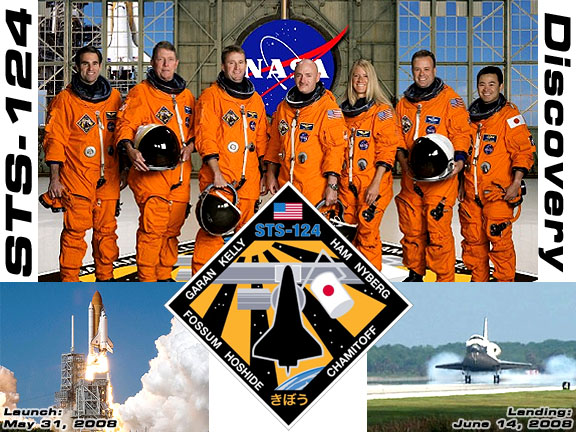 STS-124 | Space Shuttle Discovery Space station construction flight 1J Launched May 31, 2008 | Landed June 14, 2008 Crew: Mark Kelly (Commander), Kenneth Ham (Pilot), Karen Nyberg (Mission Specialist 1), Ronald Garan (Mission Specialist 2), Michael Fossum (Mission Specialist 3), Akihiko Hoshide (Mission Specialist 4), Gregory Chamitoff (ISS Flight Engineer 2 – up), Garrett Reisman (ISS Flight Engineer – down) The Mission: May 31 saw the liftoff of Discovery from pad 39A on mission STS-124 at 5:02 PM. The launch not only got the shuttle and crew into orbit but it also blew away a large portion of the wall in the launch pad's flame trench. This cavity below the launch platform, designed to direct the engine flames down and away from the vehicle, suffered extensive damage from the engine blasts, shooting bricks and debris from the sidewalls well away from the pad. Shuttles have been launched from two pads in Launch Complex 39. These are the same pads that date back forty years to the Apollo program and the Moon missions. Since pad 39B has been shut down for conversion to the upcoming Constellation program, only 39A is available for shuttle use. With the flame trench out of commission, it was necessary to start repairs as soon as possible to meet the desired August launch date of Atlantis on STS-125 (a mission that would be postponed for other reasons, but more on that later). Working around the clock, crews were able to repair the flame trench that had weathered twelve Saturn V (Apollo) and sixty-nine shuttle launches since 1967. This particular flight was carrying with it the largest habitable station payload to be delivered by the space shuttle, the Japanese Experiment Module (JEM-PM). This massive laboratory filled the shuttle's payload bay to the point that the previous mission, 123, had to leave the sensor boom behind. Post-Columbia mission regulations dictate a focused inspection of the shuttle's heat shield using the OBSS and, with STS-124 not being able to carry the boom with them to the station, the only available workaround was to have the boom already at the station when Discovery arrived. This required the heat shield inspection to occur on Flight Day 5 rather than Flight Day 2, when the shuttle would be en route to the orbital outpost. Three spacewalks were required to install and outfit the Kibo laboratory. Flight engineer Gregory Chamitoff was also delivered to the station on this flight, relieving Reisman as Expedition 17 crewmember. A bit of humor was tossed around about this flight by the media, who seemed unnaturally fixated on the ISS' recurring toilet problems. The station's bathroom had been acting up, forcing the crew to use the infrequently-used toilet on the Soyuz and urine-collection bags. A very last minute payload to the shuttle, already standing on the pad, provided replacement parts for fixing up the station's privy. The mission ended with Discovery's landing at Kennedy Space Center at 11:15 AM on June 14. The mission had lasted 13 days, 18 hours, 13 minutes, and 7 seconds. Personal Anecdote: Kim's going away party just happened to coincide with launch day! Not that I'm the sort of person who's above seeing his friends off to Europe but I rationalized that I could catch the 5:02 launch and still be to the party at a reasonable time. I got there around 5:30 and stayed until the wee hours of the morning. In any case, had there not been a launch, I wouldn't have shown up until 3 or 4, so I wasn't too late! It was a good party, though. 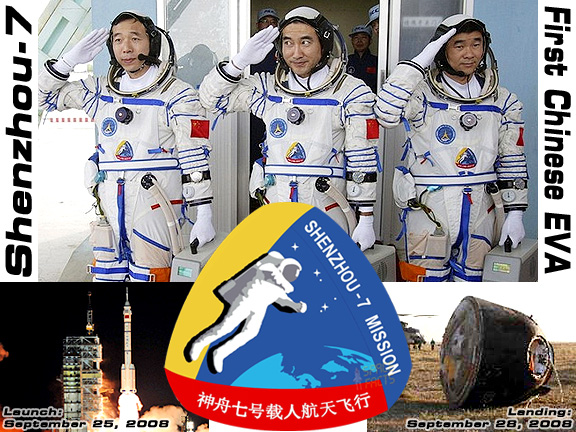 Shenzhou 7 Launched September 25, 2008 | Landed September 28, 2008 Crew: Zhigang Zhai (Commander), Buoming Liu (Orbital Pilot), Haipen Jing (Descent Pilot) The Mission: China is the world's most recent member of the manned spaceflight community. That is, to say, a nation who has developed and funded a successful manned launch vehicle and placed it and its occupants safely into orbit. In doing so they have joined Russia and the United States in this unique club and, despite political differences on the ground, China's accomplishments in space should be congratulated. Though there's been no in-orbit cooperation between Chinese spacecraft and their Russian-American counterparts, there is a possibility of that happening at some future date. As it stands China is very quickly moving through the steps and accomplishing, in five short years, progress that took Russia and the US a decade to do. The Shenzhou vehicle, a craft based off the Russian Soyuz, had two previous manned flights -- Shenzhou 5 in 2003 was the first Chinese manned launch and Shenzhou 6 in 2005 carried two crew members. This one, Shenzhou 7, took the program a step further and established two important benchmarks: the first Chinese craft to carry a three-person crew and the first Chinese craft to perform a spacewalk outside the vehicle. With these goals in mind, Zhai, Liu, and Jing lifted off from the Jiuquan Satellite Launch Center in China's Gansu Province on September 25. The flight proceeded flawlessly, with Zhai leaving the spacecraft entirely and Liu standing in the open hatch; exposed to space but not free from the vehicle. Jing monitored the spacewalk from within. All told the spacewalk lasted twenty minutes but, despite the brevity of the event, its completion marks a huge step in China's space program. A tiny satellite was also launched from Shenzhou 7, known as BanXing. This small camera platform was used to photograph the mothership, relaying back the first photos of a Shenzhou spacecraft in Earth's orbit. One incredible incident occurred shortly after the completion of the spacewalk, when Shenzhou 7 passed, unannounced, within 45 miles of the ISS. Not that the station is in elitist space, but when you have two spacecraft traveling at 17,000 mph, a matter of 45 miles is a dangerously close margin. That NASA or Roskosmos (RKA) were left entirely in the dark about this maneuver casts more light on the severity of this event. China may be a newcomer to the game but this sort of irresponsible behavior cannot become a norm. In any event, with their mission a success, the three taikonauts landed in Mongolia on September 28, having completed 48 orbits in 2 days, 20 hours, and 28 minutes. Personal Anecdote: A frustrating aspect of the Chinese space program is its lack of information. NASA and RKA release their information, names, images, and insignia as soon as it comes out, and sometimes up to a year before the mission begins. In the case of Shenzhou 7, the names of the crew weren't even known by the general public until ten days before launch and the liftoff time came mere hours beforehand. As a mission patch enthusiast, this is doubly aggravating as graphics of the insignia were not even put out. The insignia used in the graphic above had to be extrapolated by Jorge Cortes in Spain based on fuzzy photos of the spacesuits. Cortes is a fine artist who co-created the STS-126 patch (seen below) with Tim Gagnon of Florida, so his interpretation of this Chinese patch is not without understanding and talent. Gagnon and Cortes have also collaborated on the STS-127 and Expedition 22 patches that will fly later this year. 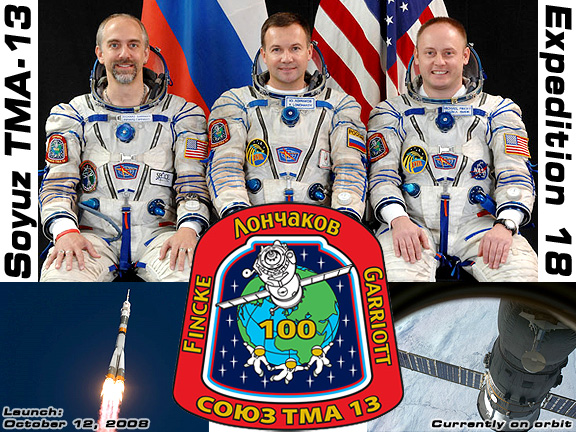
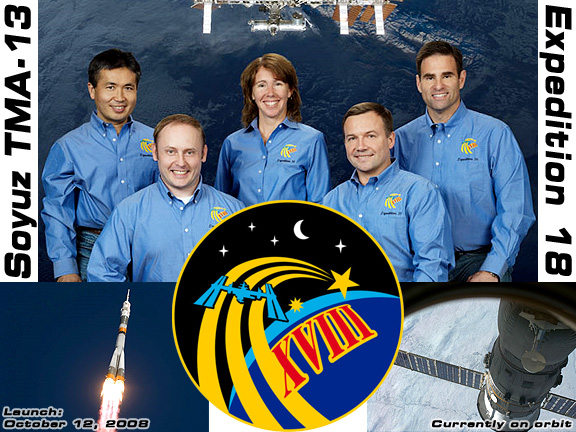 Soyuz TMA-13 | Expedition 18 Launched October 12, 2008 | Currently in orbit Soyuz TMA-13 crew: Yuri Lonchakov (Commander), Michael Fincke (Flight Engineer), Richard Garriott (Spaceflight Participant – up), Charles Simonyi (Spaceflight Participant – down) Expedition 18 crew: Michael Fincke (Commander), Yuri Lonchakov (Flight Engineer 1), Gregory Chamitoff (Flight Engineer 2), Sandra Magnus (Flight Engineer 2), Koichi Wakata (Flight Engineer 2) The Mission: Another six months passes, another Soyuz launches. TMA-13 left the launch pad at Baikonur at 1:01 PM local time (2:01 AM EST), October 12. On board the vehicle were two members Expedition 18 crewmembers, Michael Fincke and Yuri Lonchakov, and spaceflight participant Richard Garriott, a video game designer and son of former astronaut Owen Garriott, which makes him the second second-generation space traveler. That he and Sergei Volkov, the first to claim that honor, just happened to meet up in space is simply coincidence. Or is it Kismet? Though this was Garriott's first flight into orbit, his crewmates had been prior visitors to the space station: Fincke had previously spent six months on board as flight engineer during Expedition 9 in 2004; Lonchakov had flown as a mission specialist aboard Endeavour during STS-100 in April 2001 and in October 2002 took N'Sync vocalist Lance Bass' vacant seat on Soyuz TMA-1, a taxi flight to the ISS, returning with Soyuz TM-34 (taxi flights were needed because the older Soyuz TM models could not spend a full six months in orbit and had to be swapped out. The upgraded Soyuz TMA models can now spend those six months docked to the station making taxi flights unnecessary). Chamitoff transferred to Expedition 18 after Volkov and Kononenko returned to Earth, though November saw the arrival of STS-126 Endeavour and with it his replacement. Sandra Magnus, herself a veteran of STS-112 aboard Atlantis in 2002, took Chamitoff's place on the station. That shuttle mission's goal was to resupply the station and boost its crew capacity to six long-term members, a census that will be realized by the summer of 2009. While on board the station, the joint Expedition 18 and STS-126 crews celebrated the tenth anniversary of the International Space Station's launch to orbit. The complex has grown immensely since that first Russian module was blasted into space on November 20, 1998 and these coming two years will see its completion as the most advanced space laboratory ever built. Fincke and Lonchakov performed a spacewalk on December 23. Still concerned with the problems that had befallen the pyro bolts on TMA-10 and TMA-11, the Expedition 18 crewmembers placed a Langmuir probe, a device that measures electromagnetic energy, on the station's Pirs airlock. This probe will measure energy levels around the bottom-aft end of the station with the hope of sussing out potential causes for the recent Soyuz mishaps. At the time of this writing Expedition 18 has only been in orbit for three months. Their replacements, Expedition 19 aboard Soyuz TMA-14, are due to arrive in March. Until that happens, this station crew still has quite a bit of work to do, and I'll tell you about that in the 2009 report, next January. Personal Anecdote: The upwards leg of Soyuz TMA-13 took up someone that Charles and I had both heard of, but through entirely separate backgrounds. I knew of Richard Garriott as being the son of former astronaut Owen Garriott, veteran of Skylab 3 in 1973 and STS-9 Columbia in 1983. I knew of Owen and, when his son Richard was announced to fly on TMA-13, that relationship is the one I clung to. For Charles it was much different, for Richard Garriott is maybe better known by his pseudonym: Lord British. Garriott is a video game designer and the mind behind Ultima and Tabula Rasa, where he has adopted the moniker "Lord British" as a means of self-identification. In his personal patch, he settles the differences Charles and I had by including the Vitruvian Man from his father's Skylab 3 patch as well as a three-bladed symbol that apparently has some importance in Tabula Rasa. 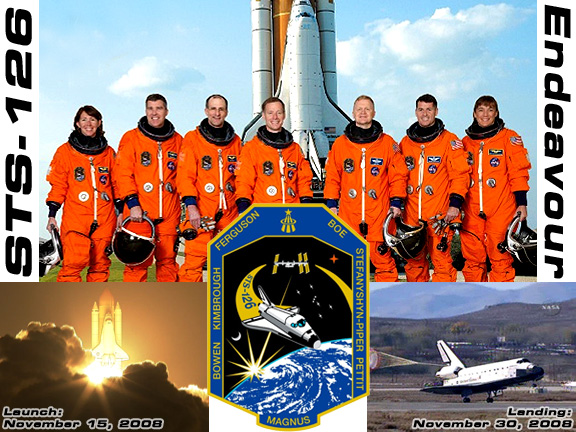 STS-126 | Space Shuttle Endeavour Space station construction flight ULF2 Launched November 14, 2008 | Landed November 30, 2008 Crew: Christopher Ferguson (Commander), Eric Boe (Pilot), Donald Pettit (Mission Specialist 1), Stephen Bowen (Mission Specialist 2), Heidemarie Stefanyshyn-Piper (Mission Specialist 3), Robert Kimbrough (Mission Specialist 4), Sandra Magnus (ISS Flight Engineer 2 – up), Gregory Chamitoff (ISS Flight Engineer – down) The Mission: Shuttle Endeavour rolled out to launch pad 39B on September 18. Despite this pad being closed due to conversion to support the Constellation Program, the shuttle nonetheless took up residence on this pad. The reason for this was because Discovery was already on pad 39A being readied for the mission to service the Hubble Space Telescope on October 14. Post-Columbia disaster guidelines dictating new safety policies state that, should a problem befall the vehicle in flight, the crew is to take up residence at the space station until another shuttle can be launched to retrieve them. This is a fine policy when all but one remaining flight will be to the ISS, but STS-125 presented a different problem: it would not be capable of docking with the station in a crisis due to the higher orbit of the Hubble. For that reason, Endeavour was rolled out, to be ready at a moment's notice to launch a rescue flight should Discovery be impaired. This rescue mission, STS-400, would be strictly launch-on-need, carrying a four-man subset of the STS-123 crew. A different sort of crisis struck when, on September 27, a mere two weeks before launch day, communications with the Hubble were lost. The problem was a malfunction of the telescope's Science Instrument Command & Data Handling Unit, prompting a switch-over to the redundant and never used "Side B" system. While control of the telescope has been regained, the STS-125 mission found itself postponed until May 2009 and STS-126 was given the go-ahead to launch in advance of that flight. Discovery rolled back to the Vehicle Assembly Building and Endeavour moved over to pad 39A (allowing construction to continue on 39B as a result). STS-126 was able to launch to the ISS at 7:55 PM on November 14. This mission's priorities were three-fold. First, to resupply the station with necessary supplies stored in Leonardo, a Multi-Purpose Logistics Module (MPLM) stored in the shuttle's payload bay that serves as a sort of large moving van. Second, to transform the station's three-person crew capabilities to become capable of supporting six-person crews. Third, over the course of four spacewalks, to clean and repair the Solar Alpha Rotary Joint (SARJ) on the starboard solar array truss. The SARJ, which allows the solar arrays to rotate and track the sun, became sluggish and, with the discovery of metal filings on the mechanism's race ring last year, the arrays have had limited mobility and were in dire need of repair. This meant that spacewalkers had to spend hours outside cleaning, relubricating, and installing new trundle bearing assemblies onto the SARJ. It was on the first of these EVAs that an expensive crew lock bag managed to get away from spacewalker Heidimarie Stefanyshyn-Piper. Hyped by the media as "your tax dollars at work," the problem occurred when a grease gun exploded in her tool bag. As Stefanyshyn-Piper struggled to wipe grease off her equipment, the crew lock bag floated out of her reach, despite a desperate grasp for its trailing shoulder strap. A completely innocent error that meant the two spacewalkers had to share tools on subsequent EVAs. Aside from this slip-up, the mission went off without a hitch. The transfer from the MPLM went smoothly and a whole host of new equipment was added including extra crew bunks and a Water Recovery System (WRS), which is one of those unfortunate necessities in space, when resupply ships can only come every few months. The WRS converts urine and perspiration into filtered, purified, drinking water. The processing is fairly extensive and the end result is water just as pure as it was the first time it entered the body. With this and the replacement of the faulty toilet, waste processing for the ISS after STS-126 was a decided improvement. Thursday, November 27 was Thanksgiving Day in the United States and the joint crews celebrated with a specially-prepared dinner of turkey, green-been casserole, candied yams, and cranberry dessert. Later that evening the hatches between vehicles were closed and the shuttle undocked the next day. STS-126 came to an end at 1:25 PM on November 30 when Endeavour made a successful touchdown on the temporary runway at Edwards Air Force Base in California after storm systems over Florida made a landing there unacceptable. The main runway at Edwards had recently been replaced and the landing aids were not yet moved. This makes Endeavour the only shuttle that will use the temporary runway at this site. Personal Anecdote: The press kits that NASA releases with each mission are always just chock full of all sorts of information and more than anyone would need to know about the coming flight. I always await each press kit with anxiety to see what all's being crammed into the coming weeks. In the STS-126 press kit I found an interesting chart on page 44 that detailed water usage on Earth and in space. We on the ground may sneer and say "yuck" to the WRS' urine recycling, but we're also pampered by almost unlimited supplies of water. This chart served as just one more of a million ways the space program makes me feel humble and wasteful. Additionally, it was the release of these press kits that inspired me to write my own for certain movie marathons that I felt could benefit from printouts detailing the schedule and other trivial information. Conclusion: That marks the end of this review of 2008 in Manned Spaceflight. I'd like to make this an annual feature and 2009 should prove exciting enough. STS-119 Discovery will deliver the final solar arrays to the station in February, STS-125 Atlantis will service the Hubble in May, STS-127 Endeavour will complete Kibo in June, STS-128 Discovery is an MPLM resupply mission set for August, STS-129 Atlantis will carry up some Express Logistics Carriers in November, and STS-130 Endeavour will end the year by delivering Node 3 and the Cupola in December. Additionally, Soyuz TMA-14 will take up Expedition 19 in March, and TMA-15 will fly in May to merge into the first six-person crew, Expedition 20. Expedition numbering begins to fly with each of these changes, with TMA-16 making Expedition 21 in September and TMA-17 forming Expedition 22 shortly thereafter. Finally, 2009 may see the two-minute launch of Ares I-X in July. Though not a manned launch, this first flight of the Constellation Program from pad 39B will set the groundwork for the next program to take humans into orbit after the shuttle retires in 2010. I might go back and do a review of 2007. I did the graphics but have yet to begin the write-up. Don't hold your breath since I haven't a clue when I'll get that underway. Thanks for reading!  Articles Articles
|
 |